|
|

- Wasp body length 30mm
- Orange Spider Wasp
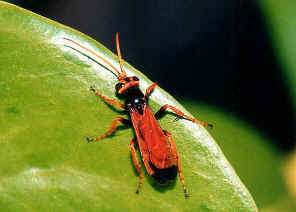

- Cryptocheilus sp, (former Salius sp.), subfamily Pepsinae, body length 30mm
- This wasp is large. Its head, legs and antenna are black and orange in colour, thorax and eyes are in black colour. Its wings are in orange colour with black tips. When we took the first photo, it was searching on leaves and ground. We believe it was looking for spider as prey to feed its young. The second picture show the wasp just came out from a hole with empty hand.
- More information and pictures can be found in this page.
- Yellow Antenna Black Wasp
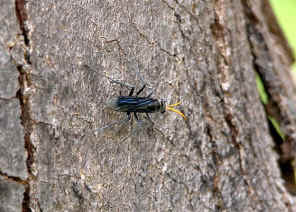

- ? Auplopus sp., subfamily Pepsinae, body length 20mm
- We sometimes see this black wasp searching prey on gum tree bark. The wasp has the long bright yellow antenna. More information and pictures please visit this page. Here we would like to thank Professor Denis Brothers sending us email advised that this wasp is in the POMPILIDAE family.
- Brown Spider Wasp
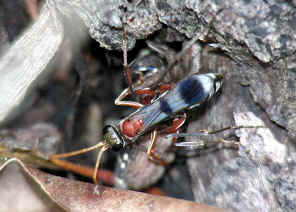
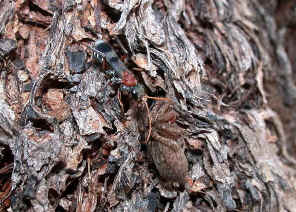
- ? Auplopus sp., subfamily Pepsinae, body length 15mm
- This wasp is relatively small as a Spider Wasp. It has the brown thorax and legs. Its head is Golden-brown in colour. On Dec 2006 in Karawatha Forest, we saw a small wasp moving a spider. More pictures and information can be found in this page.
- Grey Spider Wasp

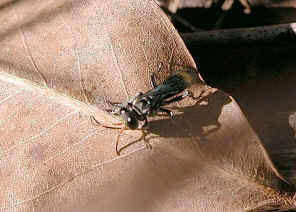
- ? Cryptocheilus sp., subfamily Pepsinae, body length 15mm
- Pictures were taken in a bush near Mt Cotton during mid winter. The wasp was searching among the plant materials on the ground.
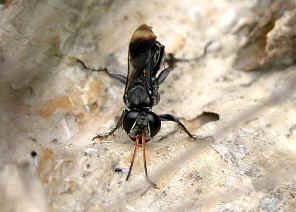
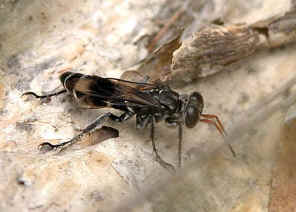
- Pictures were taken in Karawatha Forest in mid summer. The wasp was searching on the forest floor.
- Zebra Spider Wasp

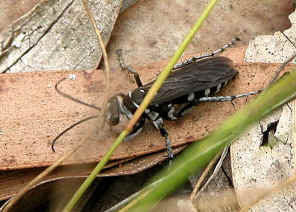
- Turneromyia sp. subfamily Pompilinae, body length 20mm
- We saw this wasp once in Karawatha Forest during early summer. It was searching on the forest floor.
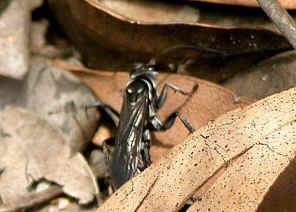
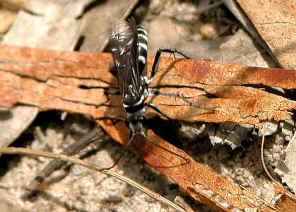
- Reference:
- 1. Insects of Australia, CSIRO, Division of Entomology, Melbourne University Press, 2nd Edition 1991, plate 5.
- Reference:
- 1. Insects of Australia, CSIRO, Division of Entomology, Melbourne University Press, 2nd Edition 1991, pp 974.
- 2. A field guide to insects in Australia - By Paul Zborowski and Ross Storey, Reed New Holland, 1996, p189.
- 3. Insects of Australia and New Zealand - R. J. Tillyard, Angus & Robertson, Ltd, Sydney, 1926, p292.
FAMILY POMPILIDAE - Spider Wasps
This page contains pictures and information about Spider Wasps that we found in the Brisbane area, Queensland, Australia.
Most member in this family are large wasps. All of them are solitary insect. A female mate and then preparing and nests and food for her young. Usually the male has shorter life span and die shortly after mating. The egg hatches and the larva feeds the supplied food, usually spiders. After pupation the new adults emerge, seek a mate and restart their life cycle.
Most of the Spider Warps are orange and black, i.e., the very strong warning colour. They usually have tinted wings, smooth and shiny body. Their legs are long and slender with prominent spurs. Females have very powerful sting. They hunt for spider, which they grasp and sting. The spider is then paralyzed and dragged back to nest and lay egg on it. The egg hatches and will feed on the spider.
In a sunny summer day, we can sometimes see Spider Warps walking, hopping and flying short distance between plants near the ground, with wings flicking rapidly. They are hunting for spiders as the food for their young. Spider Wasp provides one single spider for each cell. So they have to attack spiders about their same size or even slightly bigger. Some Spider Wasp species hunt for spiders on ground and some specially hunt for web building spiders.
